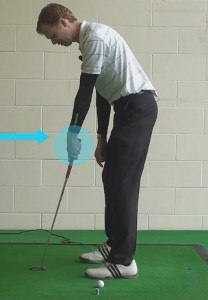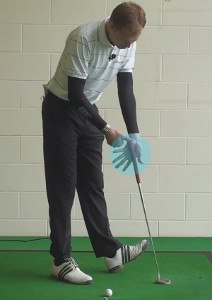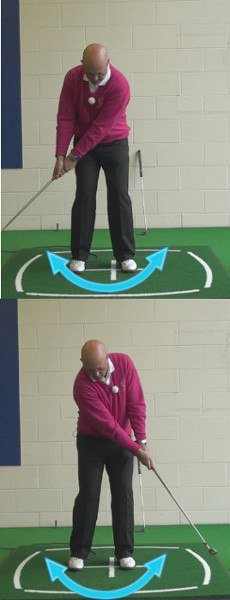
Theres no denying the simple elegance of Steve Strickers golf swing. But the real key to Strickers remarkable success has been deadly putting.
Like his full swing, Strickers putting motion is a model of simplicity. Its often described as a straight-back, straight-through (SBST) stroke, which is mildly misleading. In a true SBST stroke, the putter head follows a direct line away from the ball and through to the target, with the face square or perpendicular to this line the entire time. Stricker, like nearly everyone, actually arcs the putter on an inside-square-inside path, with the face remaining square to this curved path. His arc is less pronounced than most, leading some to call his an SBST stroke.
Technical details aside, instructors agree that Strickers putting efficiency begins with his left-hand grip. He holds the club with whats called an “un-cocked/un-hinged” left wrist. To understand this concept, hold your left arm (right arm if you're a lefty) straight out, level with the shoulder and parallel to the ground.  Point your forefinger out and your thumb up. Now, point the forefinger toward the ground by tilting the wrist downward. This is an un-cocked/un-hinged position.
Point your forefinger out and your thumb up. Now, point the forefinger toward the ground by tilting the wrist downward. This is an un-cocked/un-hinged position.
Holding the handle in this manner puts the grip more in the palms, rather than the fingers, and locks the left forearm into a straight line with the putter shaft. From this position, the left wrist remains firm throughout the stroke while the forearms rotate just enough to keep the putter face square and the shaft on plane.
If you tend to get “handsy” with your putts or suffer from excess wrist action, try Strickers grip method. Better putting may be as simple as that.

Stroke It Like Steve Stricker – How to Grip Putter with an Unhinged Left Wrist
If you ask the average golf fan to tell you one thing they know about Steve Stricker, the answer would almost always come back the same – he is a great putter. While Stricker possess a solid overall game that has allowed him to win twelve times on the PGA Tour, it is his putter that stands out as an obvious strength. While his style is slightly unusual as compared to many other players on Tour, the results are simply incredible. Despite the fact that Stricker turned professional 25 years ago, he still remains one of the best golfers in the world thanks to that reliable and repeatable putting stroke.
So what does Steve Stricker have to do with your own golf game? Well, if you can learn from his putting stroke, you may be able to then improve your own performance on the greens. While you probably wont reach the level of proficiency with the putter that has led Stricker to so many titles, you can still make improvements and lower your scores. Since putting is so vital to your score at the end of a round, even a minor improvement to your stroke could translate into saving a few shots on the scorecard.
One of the exciting things about working on your putting is how easy it is to mirror the technique of another player – even a professional. When you are working on your driver swing, for example, you would not just be able to watch a video of Dustin Johnson or Rory McIlroy and copy what they are doing. The full swing is too technical to take that approach, and the longest hitters in the world possess physical capabilities that most golfers just don't have.
Putter, however, takes very little in the way of physical capabilities. As long as you can stand over the ball and hold a good posture, you are ready to go. Therefore, using someone like Steve Stricker as a model for your own putting stroke is a great option. The stroke that Stricker uses is impressively simple and repeatable, making it an excellent model for any golfer to use. As long as you know which key elements to look for within the stroke, and are willing to put in the practice time to get comfortable with the new technique, you could be putting better in a relatively short period of time.
All the instruction contained below is based on a right handed golfer. If you play left handed, please be sure to reverse the directions so that they apply to your putting stroke properly.

What Does Stricker Do So Well?
As you would expect from one of the best putters in the world, Steve Stricker has solid fundamentals throughout hit stroke. When you watch him putt the ball, it will come as no surprise that he is able to make so many putts – his stroke looks consistent, steady, and comfortable. If you are able to mimic many of the same techniques that he uses in your own putting stroke, you will be on the right path to better results.
Following are three specific keys that Steve Stricker is able to meet with his putting stroke time after time.
- Unhinged left wrist. This is the part of his putting stroke that gets the most attention, because it is the only thing that looks a little bit unusual. At address, his left wrist is unhinged – meaning, it is turned down so that the top of the wrist is flat when it grips the club. This is different than a full swing grip, where you are going to set up with a hinged left wrist. Having a hinged wrist is correct for your full swing because you need your wrists to have the freedom to move throughout the swing and to release the club through impact. However, when you are putting, you want to eliminate wrist action as much as possible. That is why Strickers grip is so effective. By using that unhinged left wrist grip at address, he is able to effectively neutralize his wrists and take them out of the putting stroke motion. He almost has no choice but you use his shoulders exclusively to rock the putter back and through, simply because of the style of grip is uses. There is no doubt that this somewhat unique grip is one of the big keys to the success that he achieves on the putting green.
- Relaxed stance. When you watch Stricker putt, it looks as though he could stand in his address position for hours if he needed to. There doesn't appear to be anything strained or forced about his stance – he is bent over from the waist to get his eyes out over the ball, and his legs are just slightly flexed at the knees. Because it is so important to remain still through your putting stroke, you don't want to be contorting your body into an awkward address position that will be difficult to hold. Make sure your stance is comfortable so you can feel relaxed and let your mind focus on making a great stroke. It is okay if your stance doesn't look exactly like Strickers, as long as you feel comfortable and can swing the putter freely back and through.
- Smooth pendulum action. Perhaps more important than anything else is the smooth pendulum motion that Stricker is able to achieve when making his putting stroke. If you watch him putt from the face-on angle, you will see that there are really no moving parts to the stroke, other than the rocking of his shoulders. This is ideal, and this is what you should be trying to mimic in your own game. When you are able to putt the ball with a simple rock of your shoulders, the consistency and accuracy of your stroke will quickly improve. Any additional movements beyond that rocking motion are not only unnecessary, but they will also get in the way of you developing the consistency that you desire. Simple is best when putting, and very few do in better than Stricker.
Of course there is far more that makes Steve Stricker a great putter than just these three points. However, the three points that are highlighted above are a great place to start when you are trying to copy a little bit of the success that he has had on the greens. If you are able to correctly integrate these three points into your own putting performance, the ball is sure to start finding the bottom of the hole more frequently.

Learning the Grip
As mentioned above, the unique left hand grip of Steve Stricker is one of the most-identifiable parts of his putting stroke. To mimic his approach to putting, it is smart to start by copying this grip position. While it shouldn't be too hard to get your left wrist into this unhinged position at address, it will likely be quite a change from your usual grip – so expect it to feel awkward at first. Just like any other adjustment you make in your golf game, you will need to put in some practice time before the change starts to feel comfortable.
Since getting the left hand grip correct is such an important part of this process, make sure to take your time when working through the steps below.
- To start, pick up your putter with only your left hand. Take your normal grip, with your thumb running down the top of the shaft.
- Lift your arm up so that it is parallel with the ground, and the putter is pointing up to the sky.
- With your right hand, grab the middle of the shaft of the putter and start to gradually tilt it away from you. While you are doing this, your left wrist should slowly start to become unhinged.
- Continue tilting the putter shaft away from your body until the top of your left wrist is flat. By this point, the putter shaft should be almost parallel to the ground, while your left arm should be in the same position as when you started this process.
- Move the putter down to the ground and take your stance as if you were going to hit a putt. Place your right hand in position to complete the process. When done correctly, this routine should put you in a very similar position to that which Steve Stricker uses at address.
Once you finish the five steps above and get the putter down into an address position, you should have your left wrist in a great unhinged position. To check and make sure you have been successful with this process, try doing it in front of a mirror. You should have your side turned toward the mirror so that you have to look 90* to your right in order to see yourself. Complete the routine, place your putter down behind an imaginary ball, and then turn your head to the right to check your address position. You want to see that the shaft of the putter and the angle of your arms are forming a perfectly straight line (or very close to straight, at least). Seeing this straight line (or plane) formed by your arms and the putter shaft means that you have done a good job with your grip and you are in a good position to make the putting stroke.
The beauty of getting in a position that allows your arms and putter shaft to be on the same plane is that it eliminates a variable from the stroke. When you have a hinged left wrist as part of your grip, the angle that is formed between your arms and the club is susceptible to changing during the stroke. That means that there is one more thing for you to worry about going wrong. Using this unhinged grip position takes that variable out of play and makes your stroke much simpler. With each step you can take toward simplifying your putting stroke, you will get another step closer to great performance on the greens.

The Rest of the Stroke
Its great to be able to address your putts with a proper stance and great grip – but that alone wont make the ball go into the hole. If you want to actually make putts and lower your scores, you are going to need a good stroke to go with that nice address position. Getting the putter in motion and rolling the ball on your target line is a bigger challenge than just fixing your stance and your grip.
The thing that stands out about Steve Strickers putting stroke – other than the grip – is how smooth and consistent his pendulum motion really is. If you are able to mimic that kind of rocking motion in your own putting stroke, great results are likely to follow. To work toward that style of stroke, you need to use a drill on the practice green that will reinforce the proper fundamentals while still allowing you to hit putts of all different lengths. Following is the perfect drill for learning how to make a beautiful pendulum-style stroke over and over again.
For this drill, you will need normal golf equipment like your putter and some golf balls to putt with. Also, you will need either a baseball or a tennis ball. Hopefully, you have one of these around the house – if not, neither is very expensive at the local sporting goods store. It doesn't matter which option you use between a baseball and a tennis ball, so just find whatever is most convenient and head to the practice green at your local course. Also, you will need a practice partner to go with you to the golf course in order to complete this drill successfully. Hopefully, you know someone who is also working on their putting stroke, and you can take turns helping each other work through the drill.
To start, put a golf ball down on the green a few feet from a hole and take your normal stance. Make sure you are using the new grip that you have previously learned, and that your stance is athletic and comfortable. Once into position, pause at address and ask your friend to help you. Their job is to place the baseball or tennis ball between your forearms so that it is wedged in place. Have them gently push the ball down toward your wrists until it is stuck between your arms and wont fall out when they let go. Once the ball is in place, you are ready to hit some putts.
As you stroke the first putt while doing this drill, you will quickly notice that your hands and wrists have been completely taken out of the stroke. In order to keep that baseball or tennis ball in place and not have it fall to the ground during your stroke, you have to move the putter back and through simply by rocking your shoulders. If you try to engage your hands in the putting stroke at any point, the ball will likely drop. Try hitting a series of short putts while doing this drill to reinforce the feeling of using only your shoulders to move the putter through the ball. While it might feel awkward at first, you should quickly notice that you are rolling most of the putts perfectly on line and that making contact with the sweet spot of the putter has become much easier.
Feel free to hit as many putts as you would like while doing this drill. In addition to short putts, make sure you hit some longs putts as well to learn how to add speed to the putter just by increasing your shoulder motion – and not by adding hand or wrist movement to the stroke. This is a great drill, and should become something that you do on a consistent basis to monitor the condition of your putting stroke. Bad habits can develop over time on the putting green, but using this drill should effectively keep them away.
With your grip in position and your shoulders doing all of the work in the putting stroke, you should be well on your way from a mechanical standpoint. Now, it is all about repetition. Once you start playing some rounds on the course with your new putting method, old techniques may start to creep back into your mind. Spend plenty of time on the practice green so that your new putting stroke becomes natural and the old one is a thing of the past.

Beyond the Mechanics
Steve Stricker isn't a great putter just because he has an excellent putting stroke from a technical perspective – that is only one part of the equation. In addition, he also has excellent mental skills on the greens such as the ability to read putts, judge speed, handle nerves, and more. There are plenty of players on the PGA Tour who have great looking putting strokes, but very few make as many putts as Stricker. Only when you combine great technical skill with a great mental approach is it possible to putt at a high level. Below are three aspects of the mental side of putting that you should be sure to focus on.
- Green reading. It is amazing how many amateur golfers dont spend enough time or effort on properly reading the green before they putt. It does you no good to make a quality putting stroke if you aren't able to pick out the right target line in the first place. At a minimum, you should be looking at your putt from two angles – behind the hole, and behind the ball. You don't have to slow down play to do this, either. As long as you are walking quickly and reading your putts while others are playing, you can get all of the information you need without slowing down the pace of play for the groups behind you. Green reading is a skill that can be developed over time, so make it a goal to become a better green reader this golf season and your scores will be better for it.
- Patience. It might sound weird, but you have to accept the fact that you aren't going to make every putt. Steve Stricker is among the best putters in the world – and he misses putts in every single round that he plays. Golf isn't about being perfect, and that is certainly true on the putting green. With that in mind, be patient and don't try to force the ball into the hole. Make it your goal on each putt to pick out a good line, and make a good stroke. If you do those two things properly, you will make a large number of putts during a given round. However, if you lose patience and start to putt too aggressively, you could wind up with a number of three putts and a high score.
- Dealing with pressure. You are going to feel pressure on the putting green more than you feel it anywhere else on the course. Dealing with that pressure is a largely personal skill that has to be developed through trial and error. Some players deal with pressure by focusing even harder on the task at hand, while others deal with it by thinking of something else entirely. Try different strategies for dealing with the pressure when you are putting and learn what works best for you.
Steve Stricker is a great putter, and it is hard to think of a better model to look at when working your putting stroke. If you are going to use his stroke as an example that you strive to replicate, start by working on the unhinged left wrist position that he uses in his grip. Once you have that in place, use the putting drill outlined above to learn how to use your shoulders to create a beautiful pendulum stroke. Your results might not quite live up to the standard that Stricker has set, but even making just a few more putts per round will mean great things for your game as a whole.






